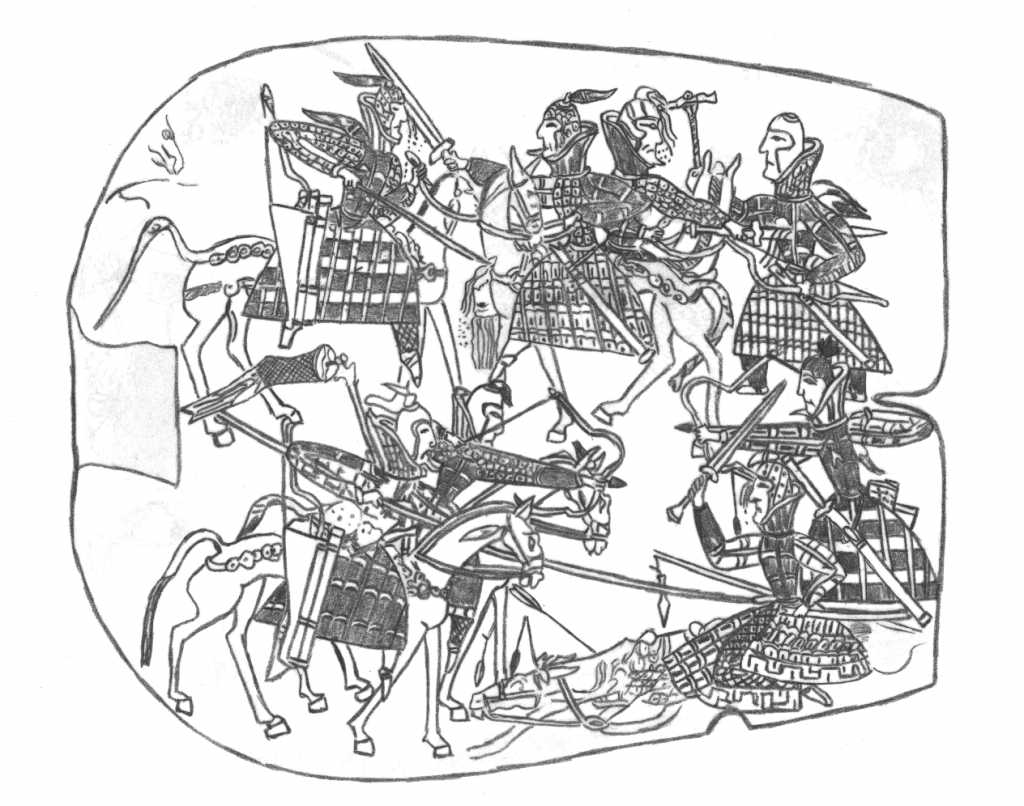|
|
Orlat Battle Plaque
2nd century BC to 2nd century AD Sarmatian [Kangju (K'ang-kiu) or Yuezhi]
or 3rd to 5th century AD Hunnic [Tashtyk, "White Huns" - the Hephthalites]

A larger image of the Orlat Battle Plaque
Extracts from Heroic fights and dying heroes - The Orlat battle plaque and the roots of Sogdian art
by Markus Mode
On the Orlat plaque with the battle image, three persons wear a pair of tassels on their shoulders.
Concerning this detail, Ilyasov and Rusanov declared: "We believe that this kind of adornment is a natural feature of the nomadic costume and horse harness."39
If this would be true we should find the shoulder-tassels on a sufficient number of pictorial representations throughout the ages.
I know, however, of only one single case:
The main person on a Northern Qi (Ch'i, AD 550-577) funerary panel in the Boston Museum of Fine Arts wears exactly this type of paired shoulder-tassels.40
Interestingly, the panel seems to belong to a Sogdian owner. Although not conclusive, this similarity may also support a later,
i.e., Hunnish-Sogdian, date of the Orlat find.
Of the two greater bone plaques from Orlat, the piece depicting a scene of fighting has been described several times and,
instead of an own attempt, we will cite the description given by the first publisher, G. A. Pugachenkova:
"There is represented a tumultuous battle scene of four pairs of mounted heroes and heroes fighting on foot.
Those, who come from the left, defeat the opponents from the right side. The fighters are distributed onto four levels from bottom to top:
1. One mounted hero is obviously the most important of all because on his horse a banner (bunchuk) is fastened.
With a long and bending lance he pierces the enemy who has been gone down on his knees.
The latter still brandishes his sword but the shaft of his lance is already cracked and his arrow-pierced horse is broken down.
2. One hero on a galloping horse bends the string of his bow, and the same does the opposite standing foe.
3. One rider from the left side has pierced the horse of his enemy with a lance.
At the latter's harness there is fastened the severed and bloody head of an earlier slain foe.
This rider divides with his sword the lancer's skull, from which blood is running.
4. One rider at the right side entirely pierced with his sword a dismounted enemy.
But the former himself dies as his skull is bashed in by the pickaxe of the warrior on foot."41
39 Ilyasov/Rusanov (1997-1998), pp. 128f.
40 Cp. Marshak (1994), fig. 14. A very good closeup of the detail can be seen in Illustrated London News, 22.4.1967, p. 23, fig. 6.
41 Pugachenkova (1987), pp. 56-57 (in Russian, translated by the author).
Bibliography
Ilyasov, J. Ya. - Rusanov, D. V. (1997-1998) A study on the bone plates from Orlat, Silk Road Art and Archaeology, 5, pp. 107-159
Marshak, B. (1994) Le programme iconographique des peintures de la "Salle des ambassadeurs" Afrasiab (Samarkand), Arts Asiatiques, t. XLIX, pp. 5-20
Pugachenkova, G. A. (1987) Obraz kangyuytsa v sogdiyskom iskusstve, Pugachenkova, G. A.: Iz khudozhestvennoy sokrovshchnicy Srednego Vostoka. Tashkent, pp. 56-65
|

